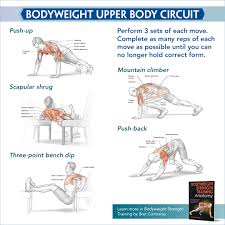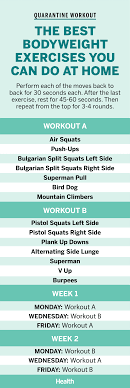The Ultimate Upper Body Strength Workout: Build Muscle and Definition
Building upper body strength is essential for overall fitness and functionality. Whether you’re looking to increase muscle mass, improve your posture, or enhance your athletic performance, a well-rounded upper body workout can help you achieve your goals.
Benefits of Upper Body Strength Training
Strength training not only helps you build muscle but also offers a range of other benefits:
- Improved posture and alignment
- Enhanced performance in daily activities and sports
- Increased bone density and joint stability
- Boosted metabolism for better weight management
- Reduced risk of injury
Sample Upper Body Strength Workout Routine
Here’s a sample workout routine to target different muscle groups in the upper body:
Push-Ups (Chest, Shoulders, Triceps)
3 sets of 12 reps
Bent-Over Rows (Back, Biceps)
3 sets of 10 reps each arm
Shoulder Press (Shoulders, Triceps)
3 sets of 10 reps
Bicep Curls (Biceps)
3 sets of 12 reps each arm
Tricep Dips (Triceps)
3 sets of 15 reps
Tips for Effective Upper Body Workouts:
- Vary your exercises to target different muscle groups.
- Maintain proper form to prevent injury and maximize results.
- Incorporate progressive overload by gradually increasing weight or resistance.
- Include rest days to allow muscles to recover and grow.
- Eat a balanced diet rich in protein to support muscle growth.
Incorporate this upper body strength workout into your fitness routine to see improvements in muscle tone, strength, and overall physical performance. Consult with a fitness professional or trainer if you’re new to strength training or have any specific health concerns.
9 Benefits of Upper Body Strength Workouts: From Improved Posture to Enhanced Confidence
- Improves posture and alignment
- Enhances athletic performance
- Increases muscle mass and definition
- Boosts metabolism for weight management
- Strengthens bones and joints
- Reduces risk of injury in daily activities
- Enhances upper body aesthetic appearance
- Improves overall upper body functionality
- Increases self-confidence and body image
Challenges of Upper Body Strength Workouts: Overtraining, Imbalances, and Injury Risks
- Risk of overtraining and muscle fatigue if not properly managed.
- Potential for muscle imbalances if certain muscle groups are overworked compared to others.
- Increased risk of injury, especially with improper form or lifting too heavy weights.
- May lead to soreness and discomfort, particularly for beginners or after intense workouts.
- Requires consistent effort and dedication to see significant results, which can be challenging for some individuals.
Improves posture and alignment
An important benefit of engaging in upper body strength workouts is the improvement it brings to posture and alignment. Strengthening the muscles in the upper body, such as the shoulders, back, and chest, helps to support the spine and maintain proper alignment. By developing a strong upper body, individuals can reduce slouching, alleviate strain on the neck and shoulders, and promote a more upright and confident posture. Improved posture not only enhances physical appearance but also contributes to overall spinal health and reduces the risk of developing musculoskeletal issues related to poor alignment.
Enhances athletic performance
Enhancing athletic performance is a key benefit of incorporating upper body strength workouts into your fitness regimen. A strong upper body not only improves your ability to generate power and speed in sports that involve throwing, hitting, or pushing movements but also contributes to overall stability and coordination. By developing strength in muscles like the chest, shoulders, and arms, athletes can enhance their performance in activities such as swimming, basketball, tennis, and football. Additionally, a robust upper body can help prevent injuries by providing better support for joints and reducing the risk of muscle imbalances during intense physical activities.
Increases muscle mass and definition
Engaging in upper body strength workouts offers the significant benefit of increasing muscle mass and definition. By targeting muscles in the chest, shoulders, back, arms, and core through exercises like push-ups, rows, and shoulder presses, individuals can effectively build strength and size in these areas. As muscles grow and develop, they become more defined and sculpted, enhancing the overall aesthetic appearance of the upper body. This not only improves physical appearance but also boosts confidence and functional strength for daily activities and athletic performance.
Boosts metabolism for weight management
One significant advantage of engaging in upper body strength workouts is their ability to boost metabolism, which plays a crucial role in weight management. As you build and strengthen muscles in your upper body through resistance training, your body’s metabolic rate increases. This heightened metabolism allows you to burn more calories even at rest, making it easier to maintain a healthy weight or achieve weight loss goals. By incorporating regular upper body strength exercises into your fitness routine, you can effectively support your metabolism and enhance your overall weight management efforts.
Strengthens bones and joints
An often overlooked benefit of upper body strength workouts is their ability to strengthen bones and joints. Engaging in regular resistance training not only builds muscle but also helps increase bone density and improve joint stability. By challenging the skeletal system through weight-bearing exercises, such as push-ups, rows, and shoulder presses, individuals can enhance their overall bone health and reduce the risk of osteoporosis and joint-related issues. Incorporating upper body strength training into your fitness routine can contribute to long-term skeletal wellness, promoting better mobility and longevity.
Reduces risk of injury in daily activities
Building upper body strength through regular workouts can significantly reduce the risk of injury in daily activities. A strong upper body provides stability and support for various movements and tasks, such as lifting objects, reaching overhead, and maintaining proper posture. Strengthening the muscles in the shoulders, back, chest, and arms helps improve overall body mechanics and reduces strain on vulnerable areas, decreasing the likelihood of accidents or overuse injuries during everyday activities. By enhancing upper body strength, individuals can move more efficiently and safely in their daily routines, promoting better physical health and well-being.
Enhances upper body aesthetic appearance
Engaging in an upper body strength workout not only boosts physical strength and functionality but also enhances the aesthetic appearance of the upper body. By targeting muscles in the chest, shoulders, back, and arms through exercises like push-ups, rows, and shoulder presses, individuals can sculpt and define their upper body muscles. This leads to improved muscle tone, definition, and symmetry, ultimately enhancing the overall aesthetic appeal of the upper body. Incorporating such workouts into a fitness routine can help individuals achieve a more balanced and visually appealing physique.
Improves overall upper body functionality
Improving upper body strength through targeted workouts enhances overall upper body functionality, allowing individuals to perform daily tasks with greater ease and efficiency. Strengthening muscles in the chest, shoulders, back, and arms can lead to improved posture, increased stability, and enhanced range of motion. This not only benefits activities like lifting, carrying, and reaching but also contributes to better athletic performance and reduced risk of injury during physical activities. By focusing on upper body strength training, individuals can experience a noticeable enhancement in their ability to move and function effectively in various aspects of their lives.
Increases self-confidence and body image
Engaging in an upper body strength workout not only enhances physical strength and muscle definition but also plays a significant role in boosting self-confidence and improving body image. As individuals witness their progress in lifting heavier weights, mastering challenging exercises, and sculpting their upper body muscles, they often experience a sense of accomplishment and empowerment. This newfound confidence translates into a positive perception of one’s body, leading to increased self-esteem and a more positive self-image. Embracing the journey of building upper body strength can instill a sense of pride and self-assurance that extends beyond the gym, positively impacting various aspects of life.
Risk of overtraining and muscle fatigue if not properly managed.
Engaging in upper body strength workouts without proper management can lead to the risk of overtraining and muscle fatigue. Overtraining occurs when the body is subjected to excessive physical stress without adequate recovery time, resulting in decreased performance, increased risk of injury, and overall burnout. Muscle fatigue, on the other hand, can hinder progress and lead to suboptimal workout results. It is essential to listen to your body, allow for sufficient rest between sessions, and adjust intensity levels accordingly to prevent these negative consequences and ensure long-term success in your fitness journey.
Potential for muscle imbalances if certain muscle groups are overworked compared to others.
One potential downside of focusing solely on upper body strength workouts is the risk of developing muscle imbalances. When certain muscle groups are consistently overworked while others are neglected, it can lead to uneven development and imbalance in strength. For example, if the chest and biceps are heavily emphasized while the back and shoulders receive less attention, it can result in postural issues and increased risk of injury. It’s important to maintain a balanced workout routine that targets all major muscle groups to prevent imbalances and promote overall strength and stability in the body.
Increased risk of injury, especially with improper form or lifting too heavy weights.
Engaging in upper body strength workouts comes with the con of an increased risk of injury, particularly when exercises are performed with improper form or when lifting weights that are too heavy. Straining muscles, overextending joints, and causing undue stress on ligaments and tendons are common consequences of pushing beyond one’s physical limits or neglecting proper technique. It is crucial to prioritize safety and gradually progress in weight and intensity to minimize the likelihood of injury and ensure a sustainable fitness journey. Regularly assessing form, seeking guidance from a qualified trainer, and listening to one’s body are essential practices in mitigating the risks associated with upper body strength training.
May lead to soreness and discomfort, particularly for beginners or after intense workouts.
Engaging in upper body strength workouts may lead to soreness and discomfort, especially for beginners or following intense training sessions. The stress placed on muscles during resistance exercises can result in muscle fatigue, micro-tears, and inflammation, leading to delayed onset muscle soreness (DOMS). It is essential for individuals starting a new upper body strength routine to gradually increase intensity and volume to allow muscles time to adapt and recover. Proper warm-up, cool-down, stretching, hydration, and nutrition are crucial in managing post-workout soreness and discomfort. Listening to your body’s signals and incorporating rest days into your workout schedule can help prevent overtraining and promote muscle recovery.
Requires consistent effort and dedication to see significant results, which can be challenging for some individuals.
Achieving significant results from upper body strength workouts requires consistent effort and dedication, which can be challenging for some individuals. Building muscle and strength in the upper body takes time and persistence, as progress is not always immediate or easily visible. It can be discouraging for those who expect quick results or struggle to maintain a regular workout routine. Staying motivated and committed to a consistent exercise regimen is essential to overcoming this con and ultimately reaping the benefits of improved upper body strength and fitness.




